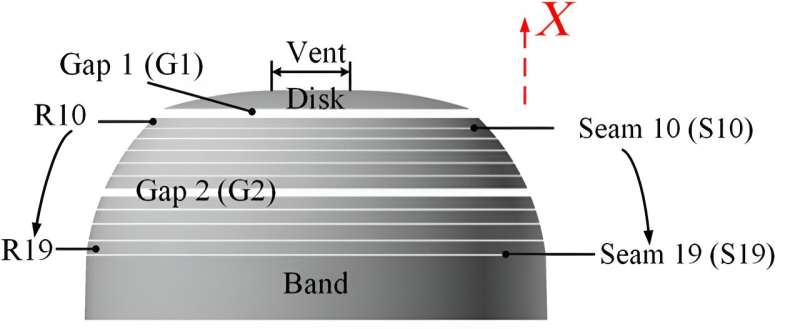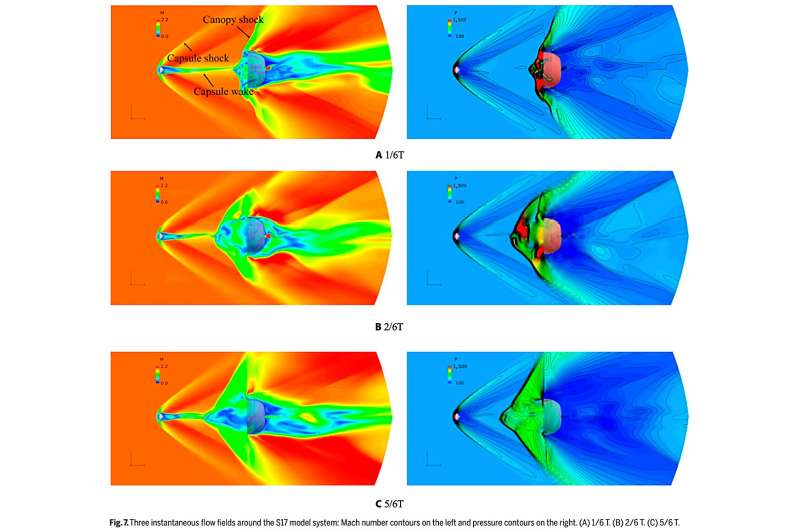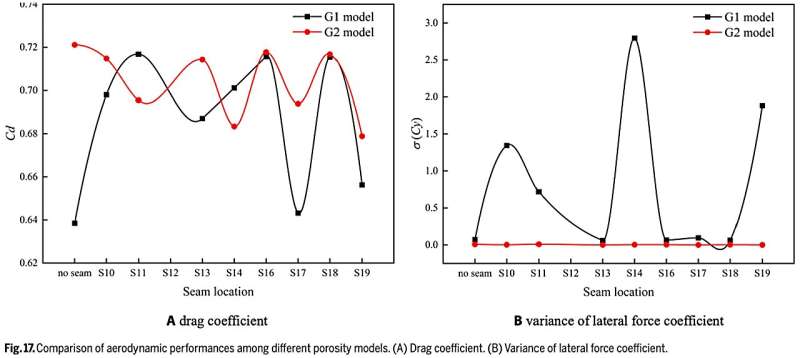This article has been reviewed according to Science X's editorial process and policies. Editors have highlighted the following attributes while ensuring the content's credibility:
fact-checked
proofread
Examining the effect of different geometric porosities on aerodynamic characteristics of supersonic parachutes

The safe landing of the probe is one of the most difficult challenges in Mars exploration, and the Mars supersonic parachute is extremely important for this process. To date, all the successful Mars exploration missions have used disk-gap-band (DGB) parachutes. However, the DGB parachute with the highest diameter of 21.35 m cannot be further used for future Mars exploration missions with higher loads.
Next-generation supersonic parachutes conducted by NASA, such as disksail parachutes, are alternatives to DGB parachutes. Disksail parachutes have larger porous gaps and smaller porous seams on the canopy surface than DGB parachutes. However, there are few studies on the aerodynamic characteristics of supersonic parachutes with different geometric porosity structures and locations.
Hence, the influence mechanism of porous seams or gaps and their locations on the performance of supersonic parachute systems in Martian atmospheric conditions remains unclear.
In a research paper recently published in Space: Science & Technology, eight scholars from five organizations, including Central South University, Xi'An Jiaotong University, Nanjing University of Aeronautics and Astronautics, Beijing Institute of Space Mechanics & Electricity, and The Hong Kong Polytechnic University, together investigate the aerodynamic characteristics of the new supersonic parachute with different porosities and seam/gap positions and understand the influence mechanism of the porosity and the positions of porous structures on the aerodynamic performances of supersonic parachutes.
First, the authors introduce the parachute model in the study. The original parachute system model used in this study includes the capsule and canopy. The canopy model is designed from the SSDS model in NASA's Low-Density Supersonic Decelerator (LDSD) flight tests, and the capsule model is consistent with the Mars Science Laboratory (MSL) probe model.

The structure of the canopy model is divided into 4 parts along the X-axis direction from the mouth to the top of the canopy body: the canopy band, the ring 19–ring 16, the ring 15–ring 10, and the canopy disk with a vent.
The canopy model has 2 types of porosity structures, i.e., gap and seam. The top gap, G1, locates between ring 10 and the canopy disk, and its geometric porosity is 4%. The middle gap, G2, locates between rings 16 and 15, and its geometric porosity is 3%. The seams locate between the other rings or the ring and canopy band. The order number of the seam is named from the upper ring. The gaps have large geometric porosity, and the seams have tiny geometric porosity.
In this study, canopy models with different single-seam positions are designed (the top vent is retained for all the models), in which only one seam is open for a canopy model. Meanwhile, the top gap model, the G1 model, is a model that only retains the top gap of G1 and the top vent, and the middle gap model, the G2 model, only retains the middle gap of G2 and the top vent. Combining the above seams with different gaps, new canopy models with different seams and gaps are also designed.
Furthermore, the canopy model is considered a rigid body in this work.
Then, authors set forth the freestream conditions and numerical methods used in the simulation. The freestream conditions used in the simulation are consistent with those of the working altitude of the supersonic parachute in the MSL mission and the working speeds of the parachute in the stable descent stage.

As for numerical methods, the unsteady flows over the supersonic parachute system (i.e., different canopy models with the same MSL capsule) are studied by numerically solving the 3-dimensional compressible N-S equations. The finite volume method is adopted for spatial discretization, and the HLLC (Harten-Lax-van Leer-Contact) scheme is employed to calculate the inviscid flux term. Furthermore, the TVD polynomial interpolation scheme is used to avoid numerical oscillations.
In addition, an implicit 2-time-step propulsion scheme is adopted to capture the complex unsteady flow field structures around the supersonic parachute with the time step of 1.0×10-4 s.
Last, the authors present the results and draw the conclusion. The numerical results are summarized as follows:
(1) The porosity structures of the canopy body have no significant effect on the flow field mode of the supersonic parachute system, and they have little effect on the pressure distribution of the capsule surface and the flow field structure around the capsule body.
(2) For the canopy models with single seams in the present study, the models with lower seams (lower side of canopy) have better drag performance, and the S11 and S17 models show larger drag coefficients and better stability performance. For the canopy models with a single gap, the drag coefficient of the G2 model (0.72) is significantly larger than that of the G1 model (0.64), while the lateral force coefficient fluctuation of G1 (0.072) is smaller than that of the G2 model (0.091).
(3) With the addition of different seams, the drag coefficient of G1S models is larger than that of the G1 model with a single G1. Compared with the original G1 model, the stability performance of the combined G1S models has no significant change. The drag performance of the combined G2S models with the seams decreases compared with the original G2 model; how- ever, the stability performance of the combined G2S models is improved compared with the original G2.

Furthermore, when the combination of seam and gap farther apart is designed for a canopy, the pressure inside the canopy basically decreases compared with the original single model, while the combination of seam and gap with a short distance is designed for a canopy and the pressure change inside the canopy is minor.
The numerical results of this study show that the new supersonic parachutes with different porosity structures of seams, gaps, and their combinations exhibit significantly different aerodynamic performances. The next generation of parachutes with more complex combinations of seams and gaps should be designed to investigate their aerodynamic characteristics and influence mechanisms.
More information: Lulu Jiang et al, Effect of Different Geometric Porosities on Aerodynamic Characteristics of Supersonic Parachutes, Space: Science & Technology (2023). DOI: 10.34133/space.0062
Provided by Beijing Institute of Technology Press Co.




















